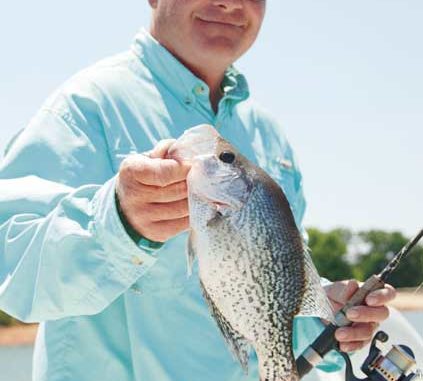
Using minnows or umbrella rigs, Lake Russell can be a July heaven for crappie fishermen.
The guy in the boat, the one drifting along the middle of a vacant, winding cove, didn’t notice the beautiful surroundings, the steep banks covered with pines and hardwoods.Nope, he was busy, his eyes glued to the small screen mounted on the dash of the boat. The depthfinder said the bottom was flat as a pancake, a bit of a surprise considering the rugged topography around him. Then, the bottom began to spike, rising from a depth of 21 feet along the edge of the meandering creek channel he was following to 12 feet under his boat.
But the spike wasn’t earth, it was wood: either a stand of trees left from before the lake was impounded, or a secret honey hole built by some other fisherman — he didn’t know. What he did know was that the solitary pile of debris he was marking looked like an underwater beehive. The swarming marks in and around the pile weren’t bees; he suspected they were a large school of crappie.
A few seconds later a rod bent over double, and the first of the “swarm” — a chunky pound-and-a-quarter crappie — came over the side of the boat.
South Carolina has its share of crappie waters, maybe more than its share. When one of the big, national tournament trails visits the Palmetto State, they have a choice of some great crappie lakes — Santee Cooper, Wateree, Clarks Hill, Murray. The one venue that’s rarely, if ever, on that list is the middle impoundment of the Savannah River, Lake Richard B. Russell.
During the spring, Russell sees a mediocre influx of crappie fishermen who work its miles of undeveloped shoreline for shallow, spawning slabs. After that, only a few dedicated slab hunters ply the lake’s deep green waters. That’s fine with Wendell Wilson, who guides on Lake Russell.
“Everybody wants to fish for crappie in the spring during March and April,” said Wilson, who is based in Elberton, Ga. “That can be a frustrating time of year, with a lot of bad weather days. July is not known for its crappie fishing, but I’ve seen a bunch of times that you can catch numbers of big crappie because they are tight to the brush, and you can find a lot of fish in one spot.”
Wilson said he sometimes has to beg that first fish to bite. He also confides that once he can get that first fish out of the brush and fighting on the line, the rest of the school will often turn on and start a feeding frenzy.
Not all areas of Lake Russell are on equal footing when it comes to fishing for summertime slabs. The cooler waters of the Savannah River that are released into the lake’s upper reaches below Hartwell Dam are a hotspot for a lot of different kinds of fish, but crappie aren’t included in that group. Nor are they often found near the oxygenated lines that cross the main-lake basin near the dam.
“I like the middle of the lake from Sanders Ferry Bridge down to the Rt. 72 bridge on the Savannah River side,” Wilson said. “The area around the state park and the golf course are also favorites. I’m also partial to crappie fishing on the Rocky River, but further up the river arm from Lowndesville to the Lake Secession spillway. I’ve caught some really big fish in that area during the spring.”
During July, Wilson admits that he’s looking to find fish in deeper water. He’s still fishing in secondary creeks and coves, not the main-river runs, which are far deeper than he needs. Most of the areas he fishes don’t even have names.
“I’m getting into the creek channels and the smaller creeks that run into the Savannah River,” he said. “These aren’t the major creeks; they’re more like big coves that have feeder creeks in the backs. I’m getting near the creek channel in about 25 feet of water.”
A lot of potential crappie fishermen are intimidated by the acres of standing timber that are visible all over the lake — and the fields of submerged timber under the surface.
Wilson relies on his depthfinder to find creek channels and isolated patches of brush on the edge of the channel. Wilson planted many of the brushpiles and found others while looking for areas to plant his own. Others are isolated spots of brush the U.S. Army Corps of Engineers didn’t cut when it built the lake.
“There are still plenty of natural brush and small trees that were not cut when the lake was impounded, especially old cedar trees that were growing on a slope too steep to cut or hanging on a creek bank,” Wilson said. “These can be a gold mine. Crappie can be found anywhere from 12 feet deep down to 20 feet deep around these old trees.”
Wilson targets these structure-hugging fish with two different tactics, both of which allow an angler to put a bait, typically a live minnow, right in the crappie’s living room.
“I like to use a minnow on a slip float if I need to get away from the brush, or I’ll just maneuver the boat right over the top and tightline,” Wilson said. “The slip float works best if you know what depth the fish are holding. You just flip the cork over the brush and have the knot set to where the bait is suspended right in the top of the brush.”
Tightlining is a simple matter of positioning your boat over the top of the structure and putting a minnow straight down on a large split-shot or Carolina rig. Wilson likes to use 6-pound monofilament with a No. 2 hook and either a No. 4 split shot crimped a couple of feet above the hook or an egg sinker of up to a half-ounce above the hook. The line can be wrapped several times through the egg sinker to keep it from sliding, or an inline swivel can be tied in to keep the weight above the hook.
“When tightlining, I’m keeping the boat as still as I can once I find the fish,” Wilson said. “Sometimes, I’ll anchor or use the trolling motor to position the boat. Some areas that have standing timber within reach will allow me to tie up in order to hold the boat still.”
Wilson said that once he’s set up on a spot, he’ll start catching fish right away if they’re there. He doesn’t spend a lot of time there if he’s not getting bit.
While Wilson is tempting Lake Russell slabs with live bait, Heath Burditt, a tackle manufacturer from the nearby town of Starr, is using artificial baits — a lot of them — and they’re tied together into one rig.
Burditt is the creator and manufacturer of the “Crappie Minibrella,” a miniaturized version of the umbrella rig that is widely popular in offshore saltwater trolling and landlocked striper fishing. He got the idea from seeing striper guides on Lake Hartwell load the boat with stripers by towing umbrella rigs that weigh as much as three pounds.
“It just hit me one day. Why couldn’t I make one of those smaller to catch crappie?” Burditt said. “Since I used to be a welder, I took some wire off a welding machine and bent one into an umbrella. I took it up to a neighbor’s pond, and I caught everything in it from catfish to (yellow perch).”
An umbrella rig can be best described as looking like a mobile that hangs over a child’s crib. Wire spreader arms make up the main supports of the rig, with baits either connected to the arms at even intervals or suspended by monofilament leaders.
Baits can be equipped with hooks for catching fish or used without to act as teasers for the hooked baits. One bait is attached to the center of the rig as a dropper and is equipped with a standard jig and hook. A typical umbrella rig is trolled, pulling the baits horizontally through the water. The beauty of the umbrella rig, regardless of the species targeted, is that it creates the illusion of a school of baitfish.
The unique aspect of Burditt’s version is that the rig is small enough that it can be trolled at a horizontal angle, or it can be tight-lined with just barely enough movement of the boat to put the bait in an undulating motion. He even has great success casting his Minibrella and reeling it past a blowdown or stickup with phenomenal success.
Burditt began making his umbrella rigs about five years ago. When he started, the rigs were almost a foot across, but after some modifications, an even smaller version of the rig exists. With this new versatility, Burditt can target Lake Russell crappie in a number of ways.
The Minibrella is trolled with an electric trolling motor. Burditt said the ideal speeds are between one-half to 2½ mph, depending on the desired depth. For July crappie on Lake Russell, he typically uses the rig without any additional weight. He’ll fish multiple rods and try to fish just above structure he marks on his depthfinder.
“Most of the time, the fish will suspend above brush or structure, and I’ll only have to get to 10 of 12 feet down to pick these fish off the top of the brush,” Burditt said.
Rather than target a particular brushpile, Burditt will troll along a secondary creek-channel break and cherry pick the most aggressive fish that are on the edges of standing timber or brush. The ideal situation is to find schools of bait holding in the same areas.
“That’s when these rigs shine,” Burditt said. “If I can find crappie up in the bait, I’ll rig two, three or four hooks and have multiple hookups on each pass through the bait.”
If the fish are deep in the structure and tight to brush or bridge pilings, Burditt will slow his presentation and tightline the rig almost straight down to the fish. With the hooks hanging eight to 10 inches below the umbrella arms, tightlining will excite deep fish enough to get one to come up and nail the lower bait. If this doesn’t work, Burdett has got a few other tricks — such as changing the trailer bait to a different color than the teaser or hooking a minnow on the jig hook.
“I’d never considered tightlining the rigs until I started selling them to some anglers up north who told me they were killing the crappie through the ice. There’s no way to troll through the ice, so it dawned on me they had to be putting them straight down,” he said.
Part of Burditt’s motivation for changing the size of his minibrella was to make the rig castable. He said that casting has always been his favorite style of fishing, and he wanted to use his minibrella to see how it fared against a single jig.
“I can cast this shorter version all day long and catch fish that are holding beside a laydown or stick-up that I couldn’t get to trolling” he said. “I catch all kinds of fish on them. A largemouth or striper that wouldn’t look twice at a single 1/16-ounce jig will chase down an umbrella because it looks like a small pod of bait. They snatch that last bait out of the pod, and that’s the one with the hook.”

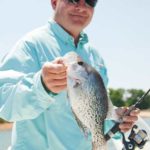
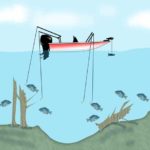
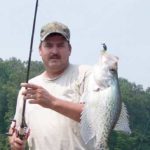
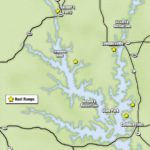
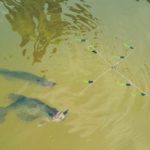
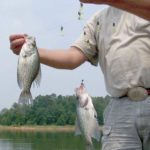
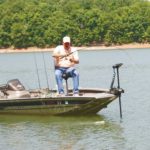
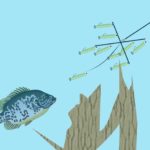



Be the first to comment